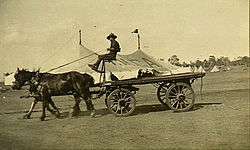Liverpool riot of 1916

The Liverpool Riot of 1916 also known as the Battle of Central Station was an event in Sydney, Australia where a large group of Australian soldiers rioted through the streets of Sydney and surrounding areas.
Following Australia's entry into World War I, many Australian men volunteered to fight in Europe and were stationed in camps around Australia to receive military training before being shipped to the front. At 9.00am on 14 February 1916, at Casula Camp in Liverpool in Sydney's south west, it was announced to the recruits that the current training session would be extended into the evening, meaning a 27-hour stretch for some of the recruits.[1] Five thousand recruits refused to accept extra duty and went on strike to protest the poor conditions at the camp. The soldiers left the camp and marched towards the centre of Liverpool, where they were joined by other recruits from camps around the area. The number of protesters now reached as many as 15 000. They invaded a number of local hotels, drinking the bars dry, refusing to pay and started to vandalise buildings.[2]
The soldiers then gained control of Liverpool train station, overpowered the engineers and commandeered trains heading towards Sydney, where they began rampaging drunkenly through Sydney streets, smashing windows and targeting anyone with a foreign-sounding name, including Italian restaurants, even though Italy was an ally of Australia in the war. Shops and hotels were looted and people were forced to take refuge in churches to avoid the soldiers. Police reinforcements were called in and began battling the soldiers in the streets of Sydney.
At Sydney's Central Railway Station, armed military guards found a group of over a hundred drunken soldiers destroying a toilet block and demanded they surrender. A shot was fired by a rioting soldier over the guards' heads and in response the guards returned fire, killing one soldier and seriously injuring eight others. This incident had a sobering effect on the soldiers and many began surrendering to police and military guards, although small bands of soldiers continued to cause damage throughout the night.
Following the riot, described as the "most disgraceful episode in our military history," about a thousand soldiers were court-martialled and either gaoled or discharged from the army.[3] However, Australia was desperate for recruits to fight the war, so many soldiers escaped punishment and were sent overseas while the government, anxious to keep the image of the Australian digger as positive as possible, discouraged the media from covering the event.[4]
As a result of the riots, New South Wales, Victoria and Tasmania introduced 6.00 p.m. closing of hotels to guard against a repeat occurrence, matching South Australia's introduction the previous year. It was not until 1955 that New South Wales closing was extended to 10 p.m.[5]
References
- ↑ "Built Heritage Assessment for the Southern Sydney Freight Line" (PDF). Caldis Cook Group.
- ↑ "THE LIVERPOOL RIOT.". The Maitland Daily Mercury (NSW : 1894 - 1939). NSW: National Library of Australia. 25 February 1916. p. 7. Retrieved 28 December 2014.
- ↑ "SENTENCES FOR MUTINY.". The Maitland Weekly Mercury (NSW : 1894 - 1931). NSW: National Library of Australia. 29 April 1916. p. 16. Retrieved 28 December 2014.
- ↑ Cockington, J. (2003) History Happened Here, ABC Books, Sydney ISBN 0-7333-1241-1.
- ↑ Freeland, J.M. (1966) The Australian Pub, Melbourne University Press, Carlton.
Additional readings
- 30 October 2014, In search of platforms 26 and 27: Central station’s mysterious underground world, The Daily Telegraph